Needs vs Wants
There has been much talk here, especially lately, about making pre-architect or pre-design lists, dividing the list into "priority needs" and "desirable wants." I've read the design and architecture books; I've searched and read dozens of related forum threads going back 3-4 years, yet I haven't found a good answer to this.
How exactly do you determine what is a "need" vs what is a "want"? Sure, no one needs a gold-plated toilet or flying squirrels carved into their roof or the like. Those are clearly wants. Do you actually "need" storage? Do you "need" central vac or do you just need a closet to store a vacuum cleaner? Maybe you only really "need" a nail on the wall to hang a broom, and all the rest is superfluous.
One could argue the points endlessly, and I've seen it done here many times where one poster adamantly claims another poster doesn't "need" such extravagance, so much space, so many toilets, or they say someone absolutely "needs" more than one bathroom, etc. In fact, when you come right down to it, all anyone really needs is basic shelter that provides one with the ability to maintain good hygiene and stay safe from the elements. Just because you have 10 kids doesn't mean you "need" 10 or 12 or even 5 bedrooms. My grandmother raised 10 kids in a 2 bedroom house. Really. Some people even live in tents. Or igloos. And use an outhouse. But that's not the point here, although I sometimes feel certain people on this forum take the question to this extreme.
For us, on this forum, people with the means to build a new, often custom, house, how should we be dividing this building list? I suppose "needs" could be classified as minimum code requirements, site limitations and orientation, local setback distances and height requirements, deed restrictions, etc. While that is a useful list to make and entirely necessary before designing any house, is this all that a "needs" list encompasses? Or does it include the more intangible things that apply to your personal goal of building a house?
And if so, where, how, do you draw the line between needs and wants, when making a list that will be useful to your design team? It's a grey area, and I'm certain it will differ between individuals. Is it dependent upon location? Family size? Budget? What?
Per the books and advice, I too made similar lists before starting, including a list of "what I don't like about my current house," and gave them to my architect, and while I got some very nice plans, it ultimately didn't get me the dream home I was seeking. Clearly I did something wrong. Starting over, I don't want to make the same mistake.
So, a penny for your thoughts...
Comments (37)
virgilcarter
11 years agolast modified: 9 years agoCritical needs vs. desirable wants is always a good way to seperate and categorize criteria for the design and construction of a house.
Rather than focus on features and objects, however, you would be better off identifying your critical needs as the various functions by various people in your family, together with the frequency of these functions.
For example, "cooking for and entertaining an extended family of 7 people three times a week", is much more useful that saying "a large granite topped island in the kitchen, and seating for 8 in the formal dining room". The former statement is a "need", while the latter statement is a solution in search of a problem! Do you see the difference?
In the end, the critical needs will be uniquely yours. No one else will be able to live your life the way you want and need to live yours. Suggestions here will be helpful, of course, but for true value you and your spouse/SO need to sit down, do the due diligence and reach mutual agreement over at least the critical needs.
There's no sense in proceeding until you reach that agreement.
Good luck on your project.
Annie Deighnaugh
11 years agolast modified: 9 years agoI understand and agree with what virgilcarter is saying, but beyond that I had "critical needs" on my list which others would consider luxuries, but were elements in the house without which I would not have been happy....like a dining room that wasn't visible from the kitchen...like a dedicated hot water heater for the master bath...like a heated towel bar in the master bath. If I'm going through the effort and expense of building a custom home, there are some luxuries that were essential...not necessarily for living, but for being happy with the finished product.
Related Professionals
Enterprise Architects & Building Designers · Bell Gardens Architects & Building Designers · Plum Design-Build Firms · Hutto Home Builders · Jurupa Valley Home Builders · Troutdale Home Builders · Avon Lake General Contractors · Cumberland General Contractors · Geneva General Contractors · Groveton General Contractors · Hamilton Square General Contractors · River Forest General Contractors · San Marcos General Contractors · Tuckahoe General Contractors · Williston General Contractorsboymom23
11 years agolast modified: 9 years agoWell, number one for us was having at least as nice, or nicer, finishes as we had in our old house. Everything was to be an improvement, kwim? Then our wants certainly won out on our kitchen. We have a child with major food allergies and can't eat out very often. therefore, we figured our kitchen was our most imp room. also, think about your entertaining style. Although certainly not a "need", we entertained all the time by our old pool, so a pool was a must for us. I could have made do with any old house, but once we decided to build, I wanted to get it perfect!! Good luck to you!
cottagewithroses
11 years agolast modified: 9 years agoThis is an interesting question. Needs are probably the reason you're building a home. Do you need more space? Do you need universal access? Do you need another bedroom or bathroom?
I suppose each person would have a unique list, so that might be why you're not finding one that fits. For many a garden might be a want, but for me it would be a need. This probably doesn't help, but it might get you started on another list of your own.
jenswrens
Original Author11 years agolast modified: 9 years agoVirgil, the intent of my post was not to collect "suggestions for needs and wants" as you implied or to use someone else's list as though I would evade my own due diligence, but rather to elicit a discussion here where forum members might expound upon the process and value of list making, and more specifically examine the imprecision of distinguishing between what defines a "need" as opposed to a "want."
That said, it IS very helpful to hear specific examples of what other people have listed as their needs so that we might extrapolate from that. I do like Annie's and cottage's definition of "needs" as being "that particular element without which it wouldn't be worth my money/time/effort to build."
Actually, virgilcarter's definition of "needs" is even a step backwards from, or a precursor to, what I believe most people think of as "needs." Yours is rather a list of "current family functions in daily life, hobbies, illnesses, habits, interests, etc" and puts the onus onto the architect or designer to interpret one's "housing needs" from that.
To me, a list like that leaves a great deal of ambiguity in the process that could either go spectacularly well or horribly wrong, depending on how well your architect can read between your lines. But perhaps that is how they are trained - to read between the lines. IDK. I see your point. Sort of. It's like psychoanalysis, but in Home 3D.
So instead of "I want/need the kitchen to face east and south to capture as much natural light as possible," I should say "I have SAD and get horribly depressed when it rains so that I can't get motivated to do laundry or dishes or feed the cats and prefer to lie in bed in the dark on those days." And then I assume my List of Wants is what helps determine whether or not I end up with a contemporary house with glass walls and glass ceilings and indoor tropical plants vs a colonial gourmet kitchen that faces east and south vs an ordinary house with a solutube or two and a zillion high-hats sporting full-spectrum bulbs.
Or instead of "I need a dedicated guest bedroom with an ensuite bath," I say, "The last time my husband had the flu, I had to sleep on a cot in the barn because that was the only other comfortable and private place available." And just hope that the architect gives me another bedroom out of it instead of simply some space for a pull-out sofa in the basement? Must I also say that I have an overactive bladder in order to get a powder room near the kitchen? Can't I just say I need a nearby powder room? :-)
I'm not trying to be snarky; I'm truly trying to understand this process. And if I did make that list, I fear it would become a long autobiography of self-psychoanalysis that I would never willingly hand over to anyone, much less my architect. In fact, I'm pretty sure I've already done that preliminary exercise, at least in my head, which is how I came to the conclusion that, hey, maybe we should build a house to solve some of these day-to-day irritations.
Or perhaps what virgilcarter is saying is that one's "needs" list is dependent upon the answers discovered during that due-diligence self-psychoanalysis exercise, and THAT list (nearby powder room, guest suite, southern light) is what is given to the architect. As an architect, which list do you prefer to get? The former or the latter? I know what is helpful to me, but what is most helpful to the architect?
cottagewithroses
11 years agolast modified: 9 years agoJenswrens, it sounds like you have had some trouble defining what you want in your new home. Or maybe not and the architect did not comprehend what you wanted.
I would do the following. Close your eyes, relax and think about what would make you happy in your new home. Don't worry about every detail, but the general things that would make your home special and lovely to you.
Once you have identified the big picture, then you can go back and focus on the details. Not only why do you want a kitchen with so much natural light, but how will it function in the evening? Will artificial light be enough or do you need warmer and brighter colors on the walls?
For me, I think my name says a lot. I would like a cottage, but large enough for my friends and family to gather together. Open spaces would be preferred, but I do like details that are more traditional but not too fancy. A big garden is a must and I'd like to be able to see the garden as much as possible. A fireplace in the living area, with a big chair nearby for reading books on a winter afternoon. A large dining table with comfortable chairs, but not a separate room. Maybe a sunny corner, open to the living area and the kitchen. And a kitchen with plenty of room for cooking and baking, but still compact enough to be comfortable for one or two on a daily basis. I'd like to have a mudroom with access to the garden, so that I can clean up before I come into the house. And bedrooms that aren't too cramped but not too large, either. Oh, and two bathrooms, one with a tub for soaking. And maybe a little powder room, off the mudroom.
That's my list, so maybe it will help you with yours a little. I hope so.
jenswrens
Original Author11 years agolast modified: 9 years agoThat's your Sweeby statement, cottage. :-) I like it! I have one too.
It's not that I don't know what I want. I do have a vision. It's clarifying that vision with an outside source (architect) and finding the best way to bring it to fruition. Which hasn't worked in the past for whatever reason. Maybe it's the architect. Maybe it's me and my lists. IDK.
It's also knowing that compromises will have to be made, and understanding the difference in Needs and Wants ultimately helps when making those critical design decisions. "Wants" can be nixed in the end. "Needs" shouldn't be.
dekeoboe
11 years agolast modified: 9 years agojenswrens - Have you read Designing Your Perfect House by William Hirsch? Mr Hirsch is an architect and he takes you through the design process. I found it very helpful to read before meeting with our architect to help get a better understanding of the process.
jenswrens
Original Author11 years agolast modified: 9 years agoYes. I have that book. It's a favorite. Read it a few years ago and revisited it before meeting with this latest architect, and then again just recently. In fact, I also bought the Kindle version just so I could bookmark and highlight parts of it so I didn't have to mess up the print hardcover version.
I've also read the others - A Pattern Language, Patterns of Home, the Susanka books, What Your Contractor Can't Tell You, How to Work with an Architect, Designing your Dream Home, Get Your House Right, the Versaci books, Big House Little House Back House Barn, etc, etc, etc. I have all of those.
This post was edited by jenswrens on Mon, Jan 28, 13 at 22:03
zone4newby
11 years agolast modified: 9 years agoI think the best definition of "need" in this context is what you must be in the plan for it to be worth it to go through the process of building.
There are plenty of houses in this world that I could live a perfectly good life in, but I wouldn't choose to build.
jenswrens
Original Author11 years agolast modified: 9 years agoYes, I agree, zone4newby. "That particular element without which it wouldn't be worth my money/time/effort to build." That is a Need.
I also think that virgilcarter's exercise is a really good one to help decide what that element is. Annie's "need" of a dining room (what she calls a luxury yet still a need) might be a "want" on someone else's list. And without going through virgil's torture assignment (just kidding!), it would be easy for someone to end up confusing the two.
I meant to add to the above post about the books -- I don't remember which book it was that recommended making these types of lists and giving them to your architect (maybe many of them did), but it didn't seem to help me much.
And then the Lists became fluid as well - after the first list and resultant plan, elements on the lists suddenly changed, and I don't think I was prepared for that. For example, suddenly it wasn't so important anymore that the stairs were on the north wall so they wouldn't block a view. Instead what was important was how close they were to the garage. The priorities change. Is that me? Is that the process? (Annie, you went through it multiple times with multiple architects. Can you comment on this?) Did it irritate my architect? Was I not prepared enough to know that the list might change? Was my architect not patient enough to deal with it?
I also wonder if maybe I've read too much. Maybe it caught my architect off guard that I knew and cared about "approach" and "orientation" and "separation of public and private spaces" etc. Maybe I expected too much. Maybe this next time I will keep quiet, play dumb, and see what happens. After all, it's only money, right? ;-)
Annie Deighnaugh
11 years agolast modified: 9 years agoAlso, we went through 6 architects over the 7 years of designing...we went back to #1...he was the only one who didn't rush to lock the door and turn out the lights when he saw us coming...the clients from hell!
;)cottagewithroses
11 years agolast modified: 9 years agoAnnie, thank you for sharing your story. I quite like the part about the architects. Have you posted any pictures of your home?
Annie Deighnaugh
11 years agolast modified: 9 years agocottagewithroses, yes I've posted many many times ... here and in home decor forum....you can search on my name and find lots...below is the link to my inspiration thread which may be helpful.
Here is a link that might be useful: Inspiration to reality
zone4newby
11 years agolast modified: 9 years agoI think you're getting at why some of us are tempted to go the DIY home design route. We needed to work through the problem to figure out what was important to us, and by the time we knew what we wanted, we knew so much what we wanted that there wasn't much left for the architect to do.
I know that we missed out on the possibility of a really fresh, dramatic design, but, honestly, my experience with hiring people for design tasks is that people who work in my price range don't actually do custom work-- they figure out which "type" of client I am, and give me that type's solution, ignoring most of my input. For example, I've had an interior decorator come in and tell me to paint all my walls beige, when I was asking how to add interest. I've come to learn that if I want custom design, the way I can afford it is to do my homework and then do it myself. I don't resent it (aside from the beige lady-- she *completely* ignored me) because design professionals need to make a decent amount for their time, and if they're charging less, its reasonable that they should be looking for ways to add efficiency.
Maybe if we had years to design a house we could keep at working with architects like Annie did, but we need someplace to live NOW.
Also, I don't know how anyone manages to plan a "forever home" they have any confidence about. To me, trying to anticipate all needs forever seems completely overwhelming, and I think I'd rather just rent, LOL! I think we've got a plan that will work well for us for the next 15-20 years, but beyond that I have no idea what will be going on with our lives. Anyhow, the idea of being wedded to a particular house forever makes me feel a little claustrophobic. I've got shallow roots. :)
invisible_hand
11 years agolast modified: 9 years ago"For us, on this forum, people with the means to build a new, often custom, house, how should we be dividing this building list? I suppose "needs" could be classified as minimum code requirements, site limitations and orientation, local setback distances and height requirements, deed restrictions, etc. While that is a useful list to make and entirely necessary before designing any house, is this all that a "needs" list encompasses? Or does it include the more intangible things that apply to your personal goal of building a house? "
I've always thought of code as the minimum statutory requirement to build rather than the definition of need. In many cases (electrical, insulation) what makes sense for a long term resident (and therefore a need) is not completely defined by code.
pps7
11 years agolast modified: 9 years agoAgree with above comments that the list will be different for different familes based on lifestyle, location, budget, lot.
Here were some of the reason we build istead of buying existing:
large mudroom with office, extra fridge, powder room and storage closets. Access to back yard from mudroom.
master and guest suite on main level.
kitchen, dining and family room with large windows to the back yard for light and view.
Basement with 10' ceilings to accomodate a home theatre.
Master closet off of master bath as DH gets up at 5:30.
Interior of home with clean lines and modern/rustic finishes compared to other homes in the area.
Small second floor with 2 bedrooms but with room to expand and accomodate live in help for special needs child.
Outdoor living.
Things that were on the wish list that ended up getting cut:
outdoor fireplace
power gate on driveway
walk out basement became look out. Mainly for drainage issues and for the safety of our special needs child. We wanted to minimize exterior doors that he could escape from.We realized that any existing home we bought would eventually require a major renovation/addition and that it would be better to build. Then the economy tanked. Oh well. As long as we stay in this house for a while we should be okay.
virgilcarter
11 years agolast modified: 9 years agojenswrens has started a very interesting discussion, with a variety of useful comments. It should probably be a "sticky" for all those thinking about a new custom-built home.
The idea of "critical needs" vs. "desirable wants" is two-fold: 1) to get owners to develop essential information for their new house that is unique to them; 2) to enable an architect to base the design around what is truly important. Focusing on these lists enables owners to focus their time, energy and discussions on something that is tangible and useful to the design process.
Each list is likely to be largely unique to those who made the list. One list may have little or nothing in common with another list. One person's "wants" may be another's "needs".
The less superficial and more thoughtful and insightful the list, the more useful it is for the architect to create a truly responsive and supportive design. For example, a "needs" list that's full of features, i.e., granite tops, laundry cubbies, 4-car garage, brass-finish hinges, Fall (as opposed to Summer) colors, etc., will result in a design that is focused on these features. On the other hand, a list that is focused on critical functions, i.e., provisions for a child with special needs or an aging parent, frequent large family gatherings, etc., will result in a design with these needs being central. A list focused on emotions, feelings and ideas, i.e., a house that provides shelter, rejuvanation and inspiration for life's challenges, will result in a design responsive to these needs.
So the "wants vs. needs" should be carefully and thoughtfully considered to truly represent what is needed and desired most.
Architectural design is a process of exploration, discovery and refinement. The best architectural design (the most evocative and enduring) is always founded on a strong, central concept--the BIG IDEA--which becomes the guiding force for how the owners needs, and as many wants as possible, are accomodated. The central concept, at its best, is drawn from the owner's most essential needs, discovered and refined by the architect with the owner's input and critique.
Designs with no central concept, no big idea, are all too often just a simple mathematical assemblage of needs and wants into a three-dimensional, (hopefully) weather-tight enclosure--upgraded shelter. This is the realm of drafters--enclosing a list of wants and needs by assembling rooms in some manner or other.
Thus, take as much time as needed to discuss and arrive at what is truly most important and essential--truly essential--for your list of needs and wants that will help transform your home from an assemblage of rooms and spaces into something much more meaningful and enduring.
Good luck with your project!
jenswrens thanked virgilcarterAnnie Deighnaugh
11 years agolast modified: 9 years agoGood point, VC...what the client focuses on in the list will be what the architect focuses on in the design as the list is a way of expressing their priorities....
Annie Deighnaugh
11 years agolast modified: 9 years agoGood point, VC...what the client focuses on in the list will be what the architect focuses on in the design as the list is a way of expressing their priorities....
new_home1024
11 years agolast modified: 9 years agoFor me, the list of needs were the things that I would be disappointed with the house if it didn't have those things. Why build a brand new house that you are disappointed with? Another way we thought about it while make individual choices, if there was something we liked but weren't sure if we should include, we asked ourselves if we would be planning and saving to add it as soon as we could, if we would be, it was something we needed to do. If we liked it but felt we were happy without it and wouldn't feel the need to plan on adding it, it was a "nice to have" and we passed on it to save budget for the things we defined as "need to have".
phoggie
11 years agolast modified: 9 years agoMost of my"needs" resulted from the necessity to have a home that was handicapped accessible...something to really consider in a build. One does not need to be"old" to consider a home like this because no one knows when an accident or illness would make this a necessity and not just a "want".
Artichokey
11 years agolast modified: 9 years agoPhoggie: At the same time, it's difficult to plan around every possible type of handicap. When I bought my house, I had difficulty walking and used a wheelchair some of the time. Two years later, I have almost no trouble walking (most days), but I've lost fine motor control in my hands. And all of my planning for mobility problems would be useless if I became blind or deaf!
virgilcarter
11 years agolast modified: 9 years agoThese are very useful comments, which help to illustrate that there really is not such thing as a "forever house", despite threads which popularize the idea (or ideal).
About the best one can do, in a changing world and a changing life, is to do one's best to plan ahead for the next 3-5 years or so. No one can see beyond that with any certainty, except to say that things will change in ways we may not be able to foresee. Thus, houses (like life) tend to be compromises after the first 3-5 years. For example, small toddlers become adolescents with far different needs; mobile adults develop conditions which may limit mobility; empty nesters get tired of the cleaning and maintenance necessary to maintain a 5,000 SF house on 10 acres; folks lose their jobs; families seperate and go in different ways; etc.
So rather than trying to design and built the ultimate "ideal house", it may be better for many to simply look ahead and plan for the next 3-5 years, letting whatever happens after that just happen.
This approach will take a lot of the pressure off couples looking to get married, thinking they need 5-6 bedroom houses with 4-car garages before getting married.
It's amazing how humans can adapt if they want to!
Annie Deighnaugh
11 years agolast modified: 9 years agoI remember being at a talk with guys who were involved in modular space and they made a strong case that modular building, not just for commercial, but for residential had a lot going for it....the couple starting out without a lot of cash can have a smalller modular home. When kids came along they could add a playroom and bedrooms. Then when the kids grew up, the empty nesters could eliminate some modules, and the elderly or infirmed could swap some out for others that met their requirements.
Certainly for people who want to live on the shore with the increasing ferocity of storms, having a house that will just wash away and can be replaced has its advantages....but then again, I've always thought that mobile home parks just attract tornados!
Unfortunately, financially that doesn't work out for most people who have the predominant amount of the savings and investment in their home....
mrspete
11 years agolast modified: 9 years agoOn one level, it's truthful to say that almost everything on this board is about WANTS. If we were just talking NEEDS, we could all buy an existing house in a good location with the right amount of space, and we'd survive. Our NEEDS would be met. So, on that level, all our discussion of window placement, types of kitchen sinks, and hardwood floors is all "above and beyond". But I don't think that's what the question really asks.
I like Annie's suggestion that a NEED is something that -- if you can't have it -- you'd just as soon not bother to build. If you can't have that luxury, that unique items specialized to your taste, you'd just as soon "make do" with a spec house.
I also agree with Annie that my perception of "my ideal house" has changed significantly as I've grown older. When we were first married and were buying our first house -- on a very limited budget -- we bought a nice, solid little ranch house that met our needs well. However, I poured over Southern Living magazine every month, dreaming of the nicer house I'd have one day: A living room AND a family room, both with big fireplaces, a formal dining room with arch-topped French doors and puddled draperies, an eat-in kitchen with a bay window . . . oh, the list went on. Now that I'm close to 50 and could easily pay cash for that house tomorrow . . . they aren't appealing to me any longer. I recognize now that in those days I focused more on the LOOK of the house. Today I care much more about a house with COMFORTABLE FUNCTION. Then I wanted to HAVE a house, now I want to LIVE IN a house. I think about how I'd enter the house, where I'd set the groceries, whether the shower is going to be easy for me to use as I grow older, whether the laundry room is conveniently placed, how the house'll work for just the two of us vs. when we have company. Also, today I don't want to tie up all my resources in a house, whereas when I was younger I would've been willing to take on a bigger mortgage. If I could have the house I envisioned as "perfect" when I was a new bride of 24, it would be no better than that first house we bought -- except that it'd have more square footage. These are changes and realizations that come with experience. So, yes, I do wonder about young people setting out to build their "forever home". When I was that age, I had neither the money nor the foresight.
And circumstances interfere: Just before I was married, I rented a large, five-bedroom house with a group of girlfriends. Our landlords were a young couple (no children yet) who'd built their dream home and then the husband (a pilot) had been transferred out of town. They weren't willing to sell it, hoping they'd return to the area one day; so they were forced to rent it. These things happen.
Can you build a "forever home"? Yes, but I think more than half the people who think they're doing so will end up moving for one reason or the other.
wkearney99
11 years agolast modified: 9 years agoWhen we designed our new house we compiled a list (a long one) of things we never wanted to put up with again. We're not so much driven by what we want, but what we DON'T want. No basement laundry or lack of kitchen pantry. No lack of hall closet or lack of room to gather at the front door. No blocked travel in the kitchen (Hello, island!). No narrow stairs, etc.
You'd be surprised how many little annoyances get overlooked/forgotten when you focus on too many new features.
So before you do focusing on what you think you "want", be sure you really identify what you never want to put up with again. Because it's the crap you hate that you'll focus on, not the features you don't end up using.
virgilcarter
11 years agolast modified: 9 years agowkearney99 raises great points of identifying what one doesn't like about one's existing house. But those should be integrated, in positive comments, into the needs and wants for a new house.
If one simply focuses on what one doesn't like about one's existing house, then that's all an architect or designer knows about the owners and that's all the owners will get--improvements to their negative comments.
Isn't it better to have a list of positive needs, wants and aspirations to be addressed in the design of a new house? Find a way to work your negative comments into positive comments about your next, new house.
Just a thought. Not trying to be critical.
cottagewithroses
11 years agolast modified: 9 years agoJenswrens, what is your list for your new home? Do you have ten or fifteen items that are necessities in your opinion? Ten more things that would be very nice, but not necessary?
As stated before, everyone's list will probably be different and your list is what will be right for you.
wkearney99
11 years agolast modified: 9 years agoOf course there are going to be positives to consider, that's a given. But without addressing the defects and actively designing ways around them you're likely to end up with the same problems. And if you're dealing with a designer or architects that aren't smart enough to grasp that then you need to be finding ones that are.
No need to 'dress it up' in flowery language.
Annie Deighnaugh
11 years agolast modified: 9 years agoI suppose it's 6 of one...
I mean we wanted one floor living, which could've been restated as no 2 floor bedrooms.... we wanted a short, level driveway, which means we didn't want a long or hilly driveway.
Some of mine were wants and don't wants: I didn't want to see the dining room from the kitchen but I did want it nearby.
I think the other issue is how long the list gets....the more fussy you are, the longer the list...the less fussy, the shorter the list. Our list was fairly long.
Artichokey
11 years agolast modified: 9 years agovirgilcarter: I think it's good to aspire to turn a negative into a positive, but sometimes we don't know enough about the possible options and close off doors unknowingly by framing a negative as a positive, or stating the negative rather than the positive would allow someone with a greater understanding to ask useful follow-up questions. Maybe I say "I don't want open up the front door and see a bathroom." That's a straightforward statement that a realtor or architect could understand. If I try to rephrase it as a positive statement, I might close off possibilities ("I want to open the front door and see the living room") or be so vague that I fail to communicate what I'm thinking ("I want the view from the front door to be welcoming.") An architect could ask why I didn't want to see a bathroom from the front door and I'd say "because my spouse has a colostomy and frequently goes into the first floor bathroom to release gas from the bag and it's really smelly. I don't want guests to smell that." And perhaps the architect could suggest putting a more powerful external vent into the first floor bath than one might normally install. (I'm thinking of an actual situation that happened when friends were building!)
virgilcarter
11 years agolast modified: 9 years agoOK, I'm convinced! It's better to get one's major needs down on paper, regardless of whether they are phrased in a positive or negative fashion--whatever expresses one's essential wants best. An experienced and talented architect is going to ask questions and probe these comments, no matter how they are phrased.
Seperating needs from wants, and getting agreement from one's spouse/SO is the main thing.
Might be a good thing if the lists didn't exceed two pages or so, but to each their own! Everyone is different!
Annie Deighnaugh
11 years agolast modified: 9 years agoI think the architect is going to have to comb the list, no matter how long, to sort out the elements and when they matter at which phases of construction. An item like granite counters is not essential as a first step for the architect whereas an item like a southern orientation is.
wkearney99
11 years agolast modified: 9 years ago> and getting agreement from one's spouse/SO is the main thing.
Beyond just agreement, it often helps to factor the SO into the situation, especially the negatives. As in, my lovely wife just does not grasp how to 'telegraph' motions in the kitchen space. As in, pay attention to what someone else is doing and time motions to work with the.
For example, if someone's doing a lot of prep on produce at some point they're going to need to get to the sink to wash it, get out the spinner to dry it, get a knife and eventually dump the leavings (disposal, compost bin, etc). All of this can be done while someone else is working in kitchen. But it helps a lot more to be aware of the other person(s) and time your motion accordingly.
Yeah, sounds great but my wife just plain does not grasp the concept. So as we designed the new kitchen space the layout was configured to allow these tasks to be performed in ways that avoid overlapping. Sounds trivial, but in the old galley style kitchen it was a serious problem. There's the negative and factoring it into the design will do a lot for marital bliss.
Had we just said 'put in an island' it likely wouldn't take as much into account. Placement and style of drawers for utensils, cabinets for equipment, trash, orientation of sink and disposal, etc. In theory a good kitchen designer (NOT your architect) will do things like this. But it has greatly helped ours to know what we really didn't like. This led to several iterations of the design to really make one that works.
Now, will this entirely eliminate the problems? No, of course not. But it'll go a long way to making day-to-day shared use of the space go a lot smoother.
So beyond just a list of desired features and negative issues, it helps to also have 'use patterns' thought out. Let your designer know how you *really* use the space, not just how a cooking or decorating magazine thinks the space "looks".
wkearney99
11 years agolast modified: 9 years agoThis is the point of addressing the negatives and seeking to eliminate or work around them. There are undoubtedly things about existing (and past) places that didn't work. Think of those, get them in your head and think hard about how new plans that evolve might run the risk of bringing those negatives back to life.
The fan comment is perfect. When I installed a very quiet separate Fantech unit I had a guest mention the lack of covering noise. Given this was a small house and that main bath had a door off just off the living room, noise could certainly be a factor for some folks. Thus the new powder room is a separated a bit more and we won't be aiming for as quiet a fan as we might choose otherwise.
That's a negative, addressed for a resulting postive outcome. But had the negatives not been brought up the same mistake might well have be repeated.
Is this a need, or a want? Well, both. You need things to function, but you don't want untintended side-effects.
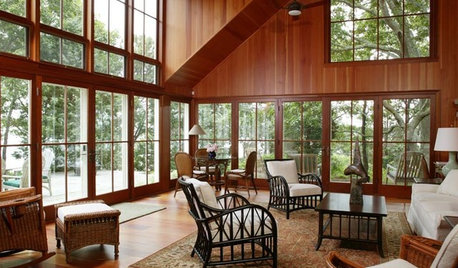
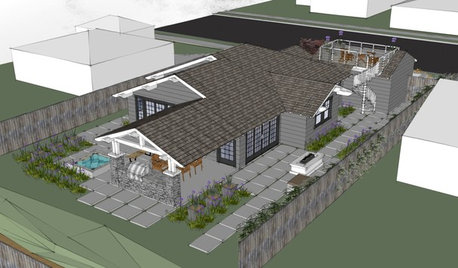
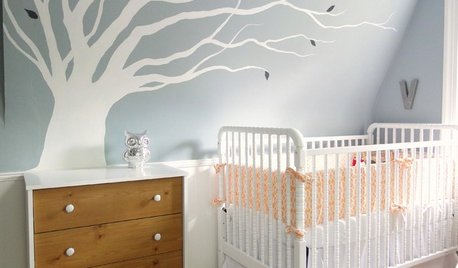
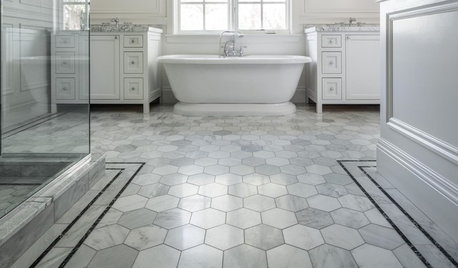
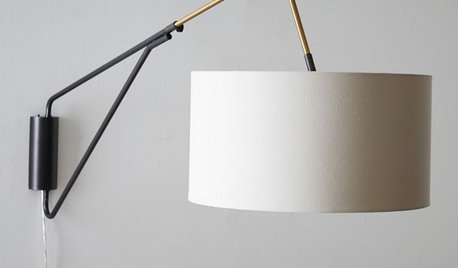

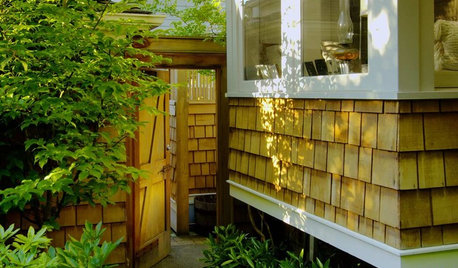
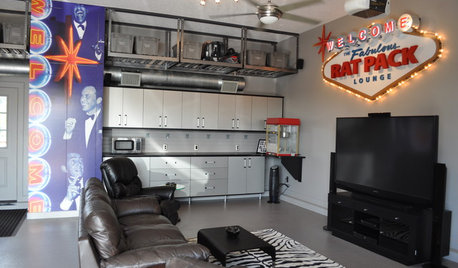

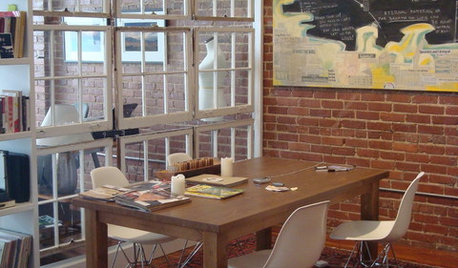







Annie Deighnaugh